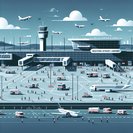
Airservices Australia has confirmed that Western Sydney International Airport will open in 2026 with a fully digital air-traffic-control (ATC) tower—Australia’s first—before the technology is rolled out to Canberra and up to five regional airports.
Instead of a traditional 360-degree glass cab, controllers will manage aircraft using high-definition panoramic screens fed by mast-mounted cameras and augmented-reality overlays. Canberra will pioneer a cross-runway remote-tower concept, monitored from a secure operations hub.
Civil Air, the controllers’ union, broadly supports the move but is demanding robust training and a phased transition, noting the interface reduces visual field to 150 degrees. Airservices plans to recruit 60 additional controllers in FY 2026 to backfill training and prepare for the national Civil-Military Air Traffic System (CMATS) launch in 2027.
Digital towers promise lower construction costs and enhanced safety features such as object tracking and night-vision, giving Australia a chance to leapfrog legacy infrastructure as travel rebounds. For airlines and travel-dependent corporates, the technology could mean faster ground movements and fewer weather-related delays on key domestic-international transfer routes.
Instead of a traditional 360-degree glass cab, controllers will manage aircraft using high-definition panoramic screens fed by mast-mounted cameras and augmented-reality overlays. Canberra will pioneer a cross-runway remote-tower concept, monitored from a secure operations hub.
Civil Air, the controllers’ union, broadly supports the move but is demanding robust training and a phased transition, noting the interface reduces visual field to 150 degrees. Airservices plans to recruit 60 additional controllers in FY 2026 to backfill training and prepare for the national Civil-Military Air Traffic System (CMATS) launch in 2027.
Digital towers promise lower construction costs and enhanced safety features such as object tracking and night-vision, giving Australia a chance to leapfrog legacy infrastructure as travel rebounds. For airlines and travel-dependent corporates, the technology could mean faster ground movements and fewer weather-related delays on key domestic-international transfer routes.









